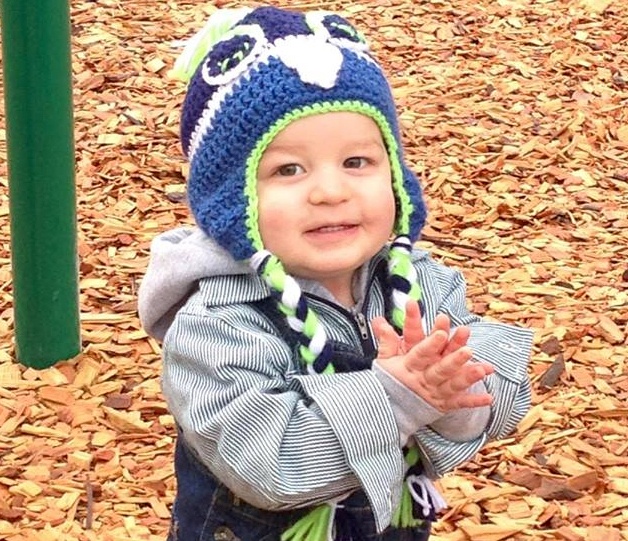BY JESSICA BROWN AND KIRK BOXLEITNER
OSO — Duke Suddarth, the youngest survivor of the Oso slide, continues to cope with the aftermath of the injuries he incurred during the devastating tragedy.
“I felt completely helpless,” said Amanda Suddarth, Duke’s mother, about her reaction to seeing her then-5-month-old son, after they were both recovered from the wreckage. “I begged God not to take him from me.”
Although her prayers have been answered, Amanda reported that Duke has sustained a loss of peripheral vision on his left side, and his skull is still healing.
“His skull was fractured, ad he underwent surgery that was supposed to repair it, but the plates apparently moved around, so his fracture is still open,” Amanda said. “The doctors aren’t entirely sure why that happened. It could be because Duke is still a growing boy.”
Duke is now 2 years old and his skull has “a spot the size of a quarter,” in Amanda’s words, that remains unhealed.
The family has an appointment with the surgical team again this spring, to try and finally fix Duke’s skull, and he’s been receiving occupational therapy in the meantime.
“That confuses people when I tell them that, because he’s a kid, so he doesn’t have a job,” Amanda said. “But it’s because he’s a little boy that he just wants to run and jump and play, and with that spot in his head, I can’t let him play as hard as he’d like.”
While Duke recovers, Amanda remains grateful to those who rescued her son.
__________
Marty Ruffner’s ambulance crew was out on drill the morning of March 22, 2014, when they first picked up radio chatter about a landslide near the tiny northwest Washington town of Oso.
Small landslides are not unusual in this forested rural area about 60 miles northeast of Seattle. The radio chirped with reports of downed power poles and lines and a barn that had slid into a road. Then it went silent.
“You really get suspicious when you don’t hear anything,” said Ruffner, who has 25 years of firefighting and paramedic experience.
So the City of Arlington Fire Department ambulance crew turned and headed toward the scene in anticipation that they might be needed. When they crested a hill on State Route 530 about four miles east of Oso, they saw this was no routine mudslide. Ruffner was the first Advanced Life Support provider to arrive on the scene of what was the deadliest landslide in U.S. history, spanning one square mile and destroying 49 homes and other structures.
“Both of my feet weren’t even on the ground when somebody thrust a coat in my hands,” Ruffner recalls. “I said, ‘What’s this?’ He said, ‘It’s a patient.'”
Wrapped in the coat shielding him from the morning chill was a barely responsive baby boy with a large area of swelling on the back of his head. The patient, who would later come to be known to his caregivers as baby Duke, was one of very few rescued from the tragic scene in Oso and his experience underscores the value of training emergency responders and other healthcare providers in basic pediatric care.
Ruffner and the other people involved in Duke’s rescue and medical care recounted his story at the fourth annual Pediatric Disaster Response Workshop hosted by the Northwest Healthcare Response Network (NWHRN) in Renton, Wash., on September 19, 2014. NWHRN is the healthcare coalition serving Washington’s King and Pierce counties. It began hosting these workshops intended for healthcare providers who are not pediatric specialists after a survey revealed that although 90 percent of the pediatric specialty beds in King County are in downtown Seattle, 90 percent of the county’s children live outside of the city. An earthquake, the threat at the top of most area hospitals’ hazard vulnerability analyses, would likely damage or destroy bridges and other infrastructure that facilitate access to the city. Separate studies have shown a similar situation in Pierce County.
“All these kids in a time of disaster will never be able to get to these pediatric hospitals,” said Dr. Vicki Sakata, NWHRN’s Senior Medical Advisor and an emergency department physician at MultiCare Health System’s Mary Bridge Children’s Hospital in Tacoma. “So all of our hospitals need to be prepared to take care of pediatric patients.”
Participants in the 2014 event included dozens of physicians and nurses from both counties, as well as volunteers from Disaster Medical Assistance Teams that may be deployed by the Federal government in an emergency. The sessions they attended highlighted resources for situations like providing burn care or performing painful procedures on children and included hands-on training in activities like administering IVs without pumps and using pediatric emergency tape to quickly determine the proper medication dosages and equipment size based on a child’s height and weight.
“For me, pediatric preparedness isn’t just for a disaster, it’s an everyday requirement,” Sakata said. “And when you don’t take care of children routinely, certain physical skills need to be practiced.”
No one would agree more than Marty Ruffner.
When Ruffner first received Duke, no one knew who or where his parents were. He was on his own to determine the appropriate care for a baby who was struggling to breathe and whose age he did not know.
Told that a helicopter was due at a designated pickup point in about seven minutes, Ruffner used a bag valve mask to help Duke breathe en route, initiated intraosseus infusion therapy to provide fluids and watched his troubling vital signs. He knew the nurses on board the helicopter that would take the patient to a hospital would likely intubate him and place him on a ventilator.
When they arrived at the pick-up scene, they were told that the helicopter they’d anticipated had picked up another patient. The next one was 20 to 25 minutes away. Duke’s vital signs were dropping and he was becoming less responsive to the bag mask ventilation; Ruffner did not believe he had that long.
Ruffner tried to use a GlideScope to intubate Duke through his swollen airway, but the batteries were dead and it did not work. To initiate rapid sequence intubation, something he very rarely did on a baby this small, he would have to administer sedatives and a paralytic agent to render Duke unconscious and flaccid. Drawing on his training, he pulled out the tape in the ambulance, sized his patient as a purple — between 10 and 11 kilograms and 74.5 to 83.9 centimeters — and pushed the corresponding recommended dosage of drugs. He then successfully intubated Duke with direct laryngoscopy. Immediately his stats improved, along with his skin color.
When the Airlift Northwest helicopter arrived and nurses Lori Avaiusini and Michael Durkin received their patient, he was very pale and barely moving, but he was breathing.
“Marty had done everything. He had this,” Avaiusini said.
This allowed the two nurses to focus on keeping Duke warm and monitoring his injuries during the flight to Harborview Medical Center in Seattle, the region’s only Level 1 trauma center.
When Dr. Elaine Albert took over Duke’s care shortly after his arrival at Harborview, there was still no information about his identity or family. Because only the sickest patients would be transferred to Harborview in this scenario, Albert knew her patient could have family members in another area hospital.
“Getting that information out and how we exchange information between emergency departments is something I think we can think about for future disasters, especially for kids,” she said.
Meanwhile, a CT revealed that Duke had a large skull fracture, and generalized, increased intracranial pressure. It was a traumatic brain injury, but babies are resilient and Albert was hopeful for his recovery. Her team inserted an intracranial pressure monitor and used the hospital’s new pediatric massive transfusion protocol to administer whole blood products, which helped support good cardiovascular volume and perfusion.
About six hours after Duke arrived, a man showed up at the hospital searching for him. Duke’s grandfather passed his caregivers’ test by identifying that his green-eyed grandson had a brown speck in one iris. The baby’s father, who had not been home at the time of the mudslide, was out searching other hospitals. Amanda had seen the slide approaching through the window of her home and placed the baby on a pillow and hugged him to her chest. It was later revealed that Duke had been found in the arms of Amanda, who had survived with severe injuries and was transported to another hospital about 50 miles from Harborview. Albert updated her on her son’s condition via phone that evening.
The sixth day after his admission, Duke’s breathing tube was removed and he was able to breathe on his own. On day nine, he was transferred to Seattle Children’s Hospital for rehabilitation, and on day 19, he was discharged.
Forty-three people died in the Oso mudslide, a tragedy that weighs heavily on the community and the region. The quick thinking of Amanda and the actions of Ruffner and the other responders in his story have made it far less painful for one family. In September of 2014, Duke was deemed healthy, as his family prepared to celebrate his first birthday in their new home.
“So much of what happened for Duke happened because people were well-trained, doing their job, anticipating and acting,” said Dr. Mary King, Medical Director of the Pediatric Intensive Care Unit at Harborview, who managed Duke’s care for the majority of his stay there. “Even if you don’t intubate children regularly, there are tools out there that can help you.”
Ruffner had in the past received annual training on pediatric care, which he identified as the most valuable tool in his possession that day. He encourages others to take advantage of similar opportunities to build their skills and help them remain confident during emergencies.
“Remember your training,” he said. “Stay calm. Just take that deep breath and say, ‘I know how to do this.'”








